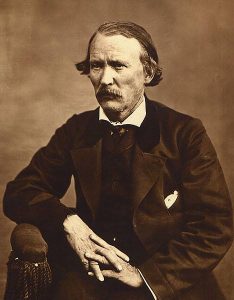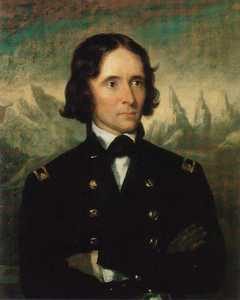from the Autobiography of Kit Carson
About the first of April, 1844, we were ready to start for home. We went up the valley of the San Joaquin, and crossed the Sierra Nevada and Coast Range by a beautiful low pass. We continued under Coast Range until we struck the Spanish trail, which we followed to the Mohave River, a small stream that rises in the Coast Range and is lost in the Great Basin. We continued down the Mohave and made an early camp at the point where the trail leaves the river. In the evening a Mexican man and a boy came to our camp. They informed us that they belong to a party of Mexicans from New Mexico. They were encamped with two other men and two women at some distance from the main party, herding horses. The man and boy were mounted, and the two men and women were in their camp, when he party of Indians charged on them for the purpose of running off their stock. They told the men and women to make their escape, and that they would guard the horses. They ran the animals off from the Indians and led them to a spring in the desert, about 30 miles from camp.
We started for the place they described, and found that the animals had been taken away by the Indians who had followed them. The Mexican asked Fremont to aid him to recover his animals. Fremont told his men that they might volunteer for the service if they wished, and that he would furnish horses for them to ride. Godey and myself volunteered, supposing that some of the other men would join us, but none did, and Godey and I and the Mexican took the trail of the missing animals. When we had gone 20 miles the Mexican’s horse gave out, and we sent him back. The night wasvery dark, and at times we had to dismount to feel for the trail. We perceived by the signs that the Indians had passed after sunset. We became much fatigued, and unsaddling our horses, we wrapped herself in the wet saddle blankets and laid down. The night was miserably cold and we could not make a fire for fear of its being seen. We arose very early and went down into a deep ravine where we made a small fire to warm ourselves.
As soon as it was light, we again took the trail, and at sunrise perceived the Indians encamped two miles ahead of us. They had killed five of the animals and were having a feast on them. Our horses could travel no farther, and we had them among the rocks and continued on afoot. We reach the camp unperceived, and crawled in among the horses. A young colt became frightened, and this alarmed the rest. The Indians at length noticed the commotion and sprang for their arms. Although they were about 30 in number, we decided to charge them. I fired, and shot one. Godey fired and missed, but reloaded and fired again, killing another. Only three shots at been fired into Indians were slain. The remainder now fled, and taking the two rifles I ascended ill to keep guard while Godey scalped the dead Indians. He scalped the one yet shot was proceeding towards the other one, who was behind some rocks. He was not dead yet, and as Godey approached he raised up and let fly a narrow, which passed through Godey’s shirt collar. Again he fell back and Godey finished him.
We rounded up the animals and drove them to the place where we had concealed our own. Here we changed horses and rode back to our camp with all of the animals, save the ones the Indians had killed for the feast. We then marched onto where the Mexicans had left the two men and women. We discovered the bodies of the men, horribly mutilated. The women, we suppose, were carried into captivity. But such was not the case, for a party traveling in our rear found their bodies very much mutilated and staked to the ground.
We continued our march without molestation till we reach the point where the trail leaves the Virgin River. There we intended to remain a day, our animals being much fatigued, the discovering a better situation, we moved our camp 80 miles farther on. Here one of our Canadians missed one of his mules, and knowing that it must have been left at the first camp, started back after it, without informing Fremont or any other party of his project. A few hours later he was missed. The members of the horse guard said he had gone to our last camp to look for his mule, and I was sent with three men to seek him. On reaching the camp we saw a pool of blood where he had fallen from his horse and knew that he was killed. We followed the trail of his animals to the point where it crossed the river that we could not find his body we can return to camp and informed Fremont of his death. In the morning he went with the party to seek the body, but it could not be found. He was a brave, noble-souled fellow, and I was saddened by his death. I had been in many an Indian fight with the Canadian, and I am confident that he if not was taken unawares, he killed one or two Indians before he fell. We now left the Virgin River, keeping to the Spanish trail, till we passed the Vega of Santa Clara, when we left the trail and struck out towards . . .


